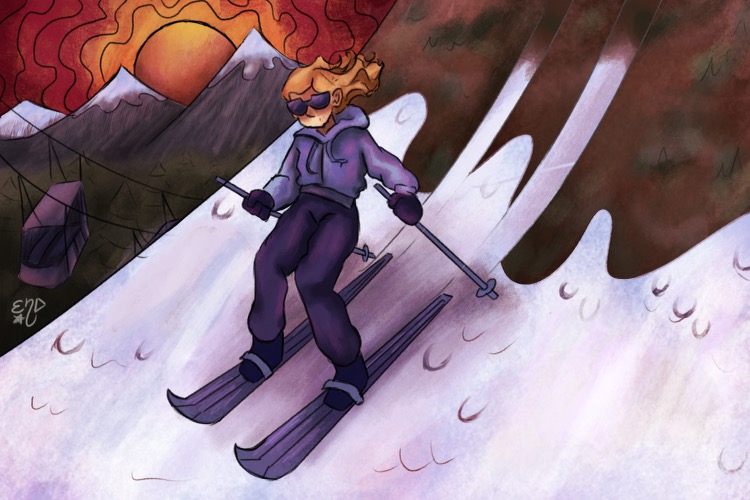Last year, while in Park City, Utah, over spring break 2023, Sofia Picciola had the best day of skiing she’d ever had. The mountain conditions were amazing: an abundance of open terrain, stable weather and soft, powdery snow. Zipping between trees on run after run, she didn’t want to stop.
But this experience was underscored by her understanding that days like these were becoming more and more rare, a phenomenon propelled by a looming threat to ecosystems and winter sports everywhere: climate change.
Despite the plentiful snow conditions and stable weather Sofia experienced on this trip, these conditions were by no means the norm throughout her time skiing. Just two years prior, the 2020-21 winter, was one of Utah’s driest on record, resulting in little snowfall and significantly fewer open trails.
“Park City, Deer Valley had no snow. It was really really like, bare minimum,” Sofia, a junior, said. “There was not a lot open, and I think that was kind of sad because they have some great terrain out there, but it was all closed because there was just too little.”
This effect of less snow and lower average temperatures across the winter season has been felt across the world. Some areas, European destinations in particular, are being hit particularly hard. Sofia’s friend, Bea Badino, skis competitively on the Equipe Pragelato team at Sestriere resort in Italy and has experienced these drastic effects in recent years.
“As an alpine skier that has experienced the effects of climate change in her lifetime, the difference is undeniable,” Bea wrote in a text message. “In the past years, it has become increasingly hard to find places with snow outside of the season.”
To solve the problem, resorts have had to turn to alternative solutions for making snow, including automating the process by using snow machines and even building indoor skiing slopes. Bea doesn’t think these actions, at least at their current stage, are feasible as long-term solutions.
“Indoor skiing stations are being built, but they are extremely expensive to maintain since the indoor temperature varies from -7 to -2, and aren’t able to efficiently replicate natural snow yet,” she wrote. “If the climate situation continues degrading at this pace, skiing will definitely be one of the first sports that will suffer the consequences as it already is now.”
In addition to annually warmer temperatures and less average snow coverage, climate change has also made weather conditions on these trips more variable. Senior Alex Fogel, who has been skiing since they were about 7 years old, has noticed changes in weather patterns across their various trips.
“I remember when I was younger, it was just kind of what you’d imagine, a typical snowy day on the mountains. But there are times where it seems icier, and it’s less safe for people to ski in certain areas,” they said. “It’s definitely making a lot of weather unpredictable and possibly dangerous for a lot of people, because they aren’t prepared for it.”
Last winter, Mammoth Mountain in California received over 75 feet of snow, a record high compared to 33 feet in a typical year. The record season kept the resort open until early August, compared to the typical late-spring closing. As a result of the unprecedented surplus, Sofia and her family were able to ski during mid-July.
“In Mammoth getting too much snow, it was really fun to ski during the summer, but I think that’s not sustainable because it was really unpredictable,” she said. “No one saw that coming the year ahead.”
The combination of decreasing snowfall averages and increasing variability in weather conditions for winter sports has made students and families more aware of the real effects, and subsequent consequences, of climate change.
“I’d like to go skiing and such in the time that I have,” Alex said. “It makes me want to not take the time I have for granted.”























































